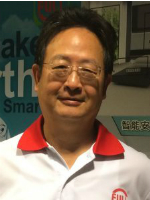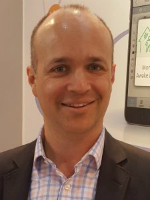The aging population is growing. It’s a common scenario around the world, especially in developed countries. In Japan, for example, senior citizens make up a whopping 27% of the total population.
The aging population is growing. It’s a common scenario around the world, especially in developed countries. In Japan, for example, senior citizens make up a whopping 27% of the total population. A lot of seniors will prefer to stay at home, and how to apply Internet of Things (IoT) technologies to bring about greater convenience or enable assisted living is a subject worth exploring.
Senior care is an underserved market. Companies have sensed the market potential and offered products/services that utilize IoT technologies.
Motion sensor is a good tool to enable automation to assist the elderly. One application is placing it on the bedside to trigger light switching. This way, when an elderly person gets up from the bed to use the toilet in the middle of the night, the light will be switched on automatically, and he won’t have to bother with feeling for the switch in the dark.
 James Yih, General
James Yih, General
Manager of Full
Enterprise
This solution is offered by Full Enterprise, an IoT enabler based in Taiwan. Falls most often occur in the bathroom and when the elderly get off the bed in the middle of the night, due to osteoporosis and the darkness, said James Yih, General Manager of Full Enterprise. “We have programmed everything so that the lights will turn on and off automatically. IoT is completely applicable in such situations.”
Sensors can also be deployed to track movement at home. Fibaro’s motion sensors, for example, can be installed in a home to detect if the resident is active and entering different areas of the home. If motion hasn’t been sensed, a caretaker will be signaled to check in on the resident. Door and window sensors can also send notifications if a resident has left or entered the home.
Fibaro solutions are also extremely helpful for the elderly who want to remain in their homes but need the comfort of a watchful eye, said Rich Bira, Managing Director of Fibaro USA. “Sensors, controllers and other devices from Fibaro’s suite help families monitor their loved ones through real-time app notifications, allowing them to safely age in place.”
AI to detect behavioral changes
The sensor technology can be pushed further to integrate artificial intelligence, which can identify which rooms are used at what times of the day, and determine if there are changes in the resident’s habits that might indicate a health issue.
 Rafi Zauer, Head of
Rafi Zauer, Head of
Marketing at Essence
Israel-based Essence Group has developed an algorithm-based system that monitors daily activities of elderly people who live at home by themselves. The company’s cloud will perform analytics with data collected from all the detection devices (sensors) around the house. Alerts to caretakers will be sent when anomalies or changes in the behaviors are detected. “It’s not an emergency alert system, but a prevention or predictive system,” Essence’s Head of Marketing Rafi Zauer stressed.
Sensors may also be modified to check on the elderly’s medicine intake. IoT solution provider MivaTek have made sensors tailor-made for this purpose. The sensors can be attached on a medicine container or even a water bottle, to track on the frequency of drug or water consumption. The company’s medication dispenser device can even lock the lid to prevent excessive consumption, or send a reminder and notification to caretakers if a senior has not taken the medicine on time.
Another use of sensor in elderly care application is placing it in the bed. The sensor can measure pulse, heart rate, blood pressure or sleep quality. Although the measurement in the bedding may not be 100% accurate, it does provide a preliminary gauge of the user’s overall physical condition, and will detect major anomalies and send them to caretakers or doctors for diagnosis.
Push button to seek help
Another smart device that can be very helpful to assist seniors is button. With the push of a button, seniors may turn on the light or other home appliances for enhanced convenience. But the more common application is using it as a panic button for distress calls.
Buttons can be placed in different areas of the house, like living room and bathroom, so that an elderly person can reach them whenever there is an emergency. By pressing the button, a notification will be sent to a family member or caretaker who will call back to check on the senior.
 Thomas Gauthier, CEO of
Thomas Gauthier, CEO of
Nodon
The button can also be a portable device to let seniors send notifications for help more easily. NIU, a smart button provided by France-based home automation company NodOn, serves this purpose.
NIU is available as an OEM solution. It connects to a smartphone App via Bluetooth. Thomas Gauthier, CEO of NodOn said, “One of our client, in the homecare sector, wanted a button to trigger an emergency call. We provided them NIU SDK to add the button to their App. This way, the user just uses the App of our client, and will be directly called back by a nurse or a doctor when he presses NIU.”
Upgraded button with fall detection and geolocation
Besides sending distress calls, a button can be added with fall detection capability. The EPA button provided by Essence is a case in point. It also has geolocation capability, so when the user falls, an alert will be sent to family members or a monitoring center, and they’ll know where the user is and send help. The button works both indoors and outdoors. The button connects over RF to a home gateway, but will automatically switch to a user’s smartphone via Bluetooth when he leaves the house.
 Li Li, Vice President of
Li Li, Vice President of
Technology
Development at
ElderSens
Many of the portable buttons hang over the user’s neck, but Silicon Valley-based startup ElderSens recently introduced a fall detector that is attached to the user’s waist. Fall detection essentially utilizes the sensor technology. “The waist is the most stable part of the body. Fall detection worn on the neck or wrist may generate many false alarms,” said Li Li, ElderSens’ Vice President of Technology Development.
ElderSens’ fall detection system also features a Bluetooth/Wi-Fi Hybrid indoor mesh network. It is a critical but not a mature technology, Li said. ElderSens sets up multiple routers in the house to create comprehensive coverage. This is needed in order to pinpoint the exact fall location indoors.